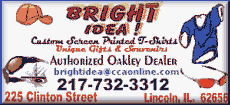 On Saturday, The Mill marked its 80th anniversary, to the date. On Saturday, The Mill marked its 80th anniversary, to the date.A
celebration began at noon and lasted into the night, as folks came
and toured the site, inside and out; reminisced over times past; and
shared a few good stories about the infamous Blossom Huffman, who
with her husband, Albert, purchased The Mill in 1945. There was also
ample time given to another colorful patron of the Mill, "Coonhound"
Johnny.
The Blue Mill was originally a small Dutch windmill-shaped
building with sails on the front that were decorated with lighting
and turned continuously. After the Huffmans purchased the little
sandwich shop, they were able to obtain, free of charge, an old Army
barracks from Fort Ellis. They moved the barracks to Lincoln and
attached it to the back of the original structure. They then
operated the business as a restaurant, bar and dance hall.
Geoff Ladd, director of the Abraham Lincoln Tourism Bureau of
Logan County and head of the Save the Mill organization, opened with
a description of the Blue Mill. He recounted the original look of
the building and the events of the grand opening, including the
Coddington children dressed as Dutch children wearing wooden shoes
and passing out roses to all the patrons.

Paul Gleason, chairman of the tourism bureau and local historian,
spoke to the audience about the history of not only The Mill, but
the county and the nation.
He reminded the audience that the same year the Blue Mill opened,
the county and city of Lincoln chose to sell the Postville
Courthouse to Henry Ford.
He used this as an example of history lost that could have been
saved and said that in 2006 The Mill also came close to being lost.
However through the Save the Mill organization, the building was
saved from destruction and will continue to be a part of the history
of the city of Lincoln and Logan County.
Others who were called on to speak about the decision made to
save The Mill included former Mayor Beth Davis-Kavelman, Lincoln
Alderwoman Joni Tibbs and county board members Pat O'Neill and Bill
Martin.
Ladd also offered certificates of appreciation to people he said
have made a substantial contribution to saving The Mill.
The "Abe Award" was given to Larry VanBibber. Ladd said that
VanBibber has been a tremendous supporter of Logan County history,
is responsible for the World's Largest Covered Wagon being brought
to Lincoln and generously donated $15,000 to the restoration project
at The Mill. Ladd also presented VanBibber with a print of Abraham
Lincoln done by local graphic designer Harry Tibbs.
"The old coot on the route," Ernie Edwards, received a
certificate, as Ladd explained that it was Edwards who first
insisted that The Mill had to be saved from demolition.

Edwards, who is 92 years of age and was the founder and owner of
the Pig Hip Restaurant in Broadwell, took the microphone and
encapsulated his life in Logan County, telling stories of his
friendship with Coonhound Johnny and the Huffmans, along with his
adventures in restaurant ownership.
Special recognition was given to John and Lenora Weiss of the
Route 66 Association of Illinois. They and a group of association
volunteers are responsible for the new sails on the front of The
Mill building.
Ladd presented them with a certificate of appreciation, an
8-by-10 print of the volunteer group that rebuilt the sails and
announced that the remnants of an original sail from the building
would be given to the Illinois Route 66 Museum, the official museum
of the Mother Road, in Pontiac.
Lenora and John both spoke to the audience about the group that
worked on the sails and the importance of preservation. It was John
who ended their comments by saying: "Something like this The Mill)
is a picture of the past. If we save these things and take care of
them, then we have created history for our future."
Also on hand for the event was Illinois Sen. Larry Bomke. He told
the audience that The Mill restoration project was a perfect example
of people coming together in a community. He reiterated that he and
Rep. Rich Brauer both are available to help in any way possible as
the group goes forward with the project.
Descendants of the original Huffman family were also recognized.
Brian Huffman, the great-grandson of Albert and Blossom Huffman and
owner of Hallie's on the square in Lincoln, has been active in the
restoration project. And, John Sutton, who is deeply involved in the
carpentry of the project, was given the "Wooden Shoe Award."
The "Behind the Scenes Award" was given to Carl Johnson, who Ladd
says has worked on a great number of projects relating to Route 66.
Bruce Huskins was recognized as one of the tourism bureau's
hardest working volunteers and the person ultimately responsible for
the annual Logan County Route 66 Garage Sale.
Misty Bell, Ladd's assistant at the tourism bureau, also took the
microphone for a moment to recognize Ladd, who has spent countless
hours working on not just The Mill project, but many other tourism
projects.
When the opening ceremony concluded, live music was provided
throughout the afternoon, the Railsplitter Auto Club had their
vintage cars on display, a food stand was opened, and visitors were
invited to sit a spell and visit, take a walk through the building
or just call to remembrance their own personal history with The
Mill.
Coonhound Johnny and Blossom Huffman trade barbs at the bar
A re-enactment provided by Spirits of Tours depicted the
personalities of Coonhound Johnny and Blossom Huffman, both of whom
played a large part in the history of The Mill.
Blossom Huffman, played by Deborah Senger, talked about her love
of dance, the charity she showed toward travelers along Route 66 and
the fun that was had at The Mill in its heyday.
She said she taught many a folk in the area to dance the waltz
and the polka and that no matter what, no one ever left The Mill
hungry. With nearly 1,800 cars stopping in on a weekend, if someone
came in without money, she fed them anyway.
She stressed that she was a lady and that activities at The Mill
were always on the up and up.
Blossom recounted a story of the Grand Reaper Motorcycle Club
coming to the door on a New Year's Eve. She said that even though
she was only 5 feet tall and weighed less than 100 pounds, she lined
those boys out that they would behave themselves. She recalled it
was the best party The Mill had ever seen.
However, when Coonhound Johnny arrived on the scene, he painted a
slightly different story of illegal pinball machines, bootleg
whiskey and visits to The Mill by well-known Chicago gangster Al
Capone.
As the two traded barbs, the history of the Mill in the 1940s and
'50s was revealed from their points of view.

Coonhound, played by Chris Hotz, told stories of running whiskey
and how he had modified the bed of his old pickup truck to hide the
'shine as he traveled along Route 66.
He told the audience that he was a good person who always looked
out for others. Blossom, rolling her eyes, agreed that he was and
that he had earned the nickname of "the Robin Hood of Logan County."
Coonhound said that he was always there to lend a hand to folks.
He told stories of helping folks in need with money and groceries
out of the goodness of his heart, plus he looked out for the
community on the whole.
Then he told the story of the time he guarded the bank, keeping
its coffers safe from robbers: "When we heard that there was maybe
gonna be a bank robbery, I sat across the street downtown with my
rifle 'cause I didn't want that to happenin'. We didn't want any
interest here in town, messin up my bootleggin' business! We didn't
need any feds runnin' around here! We had a nice situation running
nice and smooth, just the way I liked it, just the way Mr. Capone
liked it," and he looked at Blossom as he finished by saying, "and
just the way you liked it."
The two explained that the financing behind Route 66 was
primarily from Al Capone because he needed smooth, safe roads for
the bootleggers. Having such roads assured that the product would
arrive at its destination safe and sound.
[to top of second column] |

Members of the audience also got involved, recalling days of dances and youthful
shenanigans. Brian Huffman, who dropped in to surprise his great-grandmother,
recalled days when he was in trouble with his parents that he would
run upstairs and hide under the desk. He was unsure of how to put
into words his feelings about The Mill, his family heritage and the
historical significance of the business on Route 66, but he was
pleased to see that it would be saved.
One person touring The Mill spoke up and talked about his
experiences. He drove a delivery truck that provided soda pop for
the restaurant. He said that at the age of 19, he and his wife came
to The Mill, and Blossom, having poor eyesight, served him because
she couldn't see that he was too young.
He recalled Albert Huffman. "He had muscles the size of my head,"
the delivery driver said. "He said he never had to throw anyone out;
he just showed them to the door."
The Mill was also known back in the day for its wild decor. This
same gentleman recalled the jack-in-the-box toilet that made noise
when one raised the lid, the lady leg protruding from the ceiling
and a coon sticking out of a pipe.
Albert once offered up an explanation of the wild décor, saying,
"I had to keep changing things so people would come down here and
see what the crazy nut was doing now."
Are there ghosts in the attic? Well, no, but maybe upstairs!
In addition to doing re-enactments of historic Route 66 people
and events, the Spirits of Tours group conducts paranormal
investigations.

Senger is a spiritual medium and a certified paranormal
investigator with a master's degree in metaphysical sciences.
Senger claims to know when spirits are present and has evidence
of her findings in photos of orbs. She says she substantiates her
claims through historical research.
Participants were given flashlights and pads and pens to jot down
notes about what they are sensing.
Senger explained that sensing a spirit comes in different ways.
She talked about the feeling of being touched by someone, sudden
cold spots in the room or on the body, a feeling of something
crawling on the skin, times when one might suddenly become very hot,
and just the general feeling of a presence.
After an opening protection prayer, she instructed participants
to open their minds to what they might receive as they walked from
the back lawn at the Mill to its front door, touching the building
as they went.
Inside, Senger and Hotz demonstrated tools used in paranormal
investigations and talked in detail about photographing spirits in
the form of orbs.
Hotz said that many folks say that the round, bright spots that
show up in a digital photo are specks of dust reflecting the flash
of the camera.
He said that he does not believe in ghosts but still has to
question how many people thought they owned a camera good enough to
photograph a fleck of dust at 40 yards.
The group was divided into two parts and allowed to go upstairs,
where Albert and Blossom Huffman lived for a time.
They were to take notes of what they sensed and as many pictures
as they liked.
When everyone was finished upstairs, Senger led them outside to
the north side of the building, where she conducted a "channeling."
Using an audience member as the vessel for the spirit, she spoke
to a woman who claimed to be a dancer. Senger asked her about her
death, and then aided her in her answer, saying she was one who was
"in the wrong place at the wrong time."
When the group returned to the interior of The Mill and took
their seats, everyone was asked to talk about the notes they had
taken.

Many reported feelings of having their hair touched, or cold on
the back of their necks, while others talked about being tapped on
the shoulder or touched on the arm.
Several who took pictures upstairs claimed that there were
abnormalities in the photos, such as the orbs that had been
described earlier, and beams of light that resembled lasers.
At the end of the event, Senger talked about what she had felt in
her first visit to The Mill.
She said that the most important part of paranormal research was
being able to substantiate sensations with fact.
She provided a list from her first visit: notes she had taken
based on her own senses. Included in the list was the word "darkie"
face. She said that it was what came to mind, and not intended to
offend, but she had at that point in time thought that perhaps there
was a person of color who worked at The Mill.
She explained that when she did her research, she found that was
not the case. However, there was an explanation.
Behind The Mill was a coal shed, and according to Senger's
research there was some "playing around going on in there, and
apparently one time a man came out and he had gotten really involved
in what he was doing there with someone; and that has been
confirmed."
Senger also noted that there are rumors relating to Al Capone and
of one or two bodies buried outside the building. She said her
feelings did confirm that, but that she sensed a much greater number
than what has ever been spoken about. She went on to warn the
audience that this was not confirmed, so not to get carried away
with it.
However, she said that one of the many she did sense was a woman
who was killed, and it was that spirit that she had earlier helped
go into the light.
Before the event wrapped up, the balance of the Spirits of Tours
paranormal team reported on what they had observed.
They reported feelings of dread, sickness, dizziness, headache,
the words "help me, help me, help me" and a sense of feeling drunk.
One reported a feeling of being watched, and on the occasion that
the group went outside for the channeling, a sense of someone going
with them saying, "OK, good. We're not in there anymore."
The event wrapped up around 10 p.m. with many of the audience
commenting on the event, saying that they hadn't seen anything that
changed their opinion about whether or not ghosts exist in this
world, both in general and The Mill specifically, but that it had
still been a very enjoyable experience.
Before leaving, the group joined hands for a departure prayer.
Senger explained that given the chance, the spirits would go home
with participants, and the prayer would assure that didn't happen.
[By NILA SMITH]
For more information, visit:
Abraham Lincoln Tourism Bureau of Logan County
1555 Fifth St.
Lincoln, IL 62656
217-732-8687
info@abe66.com
Web site: http://www.abe66.com/
Save the Mill:
http://www.savethemill.org/
Logan County events, including the Logan County Fair, the Lincoln
Art & Balloon Festival, Abraham Lincoln National Railsplitting
Contest, fall festivals, cruise-ins, craft shows and more:
http://www.abe66.com/
 |